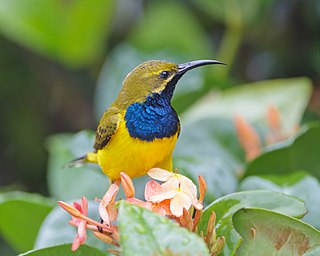
The crimson-fronted barbet, also called Sri Lanka barbet, is an Asian barbet endemic to Sri Lanka where it inhabits tropical moist lowland forests up to 1,300 m (4,300 ft) elevation.
Salomon Müller was a German naturalist. He was born in Heidelberg, and died in Freiburg im Breisgau.

Forsten's tortoise, also known commonly as the Sulawesi tortoise, is a species of tortoise in the family Testudinidae. The species is native to Sulawesi Island, Indonesia.

The uniform swiftlet,, also known as the Vanikoro swiftlet or lowland swiftlet, is a gregarious, medium-sized swiftlet with a shallowly forked tail. The colouring is dark grey-brown, darker on the upperparts with somewhat paler underparts, especially on chin and throat. This species is widespread from the Philippines through Wallacea, New Guinea and Melanesia. It forages for flying insects primarily in lowland forests and open areas. It nests in caves where it uses its sense of echolocation, rare in birds, to navigate.

The western hooded pitta is a passerine bird in the family Pittidae. It is common in eastern and southeastern Asia and maritime Southeast Asia, where it lives in several types of forests as well as on plantations and other cultivated areas. It is a green bird with a black head and chestnut crown. It forages on the ground for insects and their larvae, and also eats berries. It breeds between February and August, the pair being strongly territorial and building their nest on the ground. Incubation and care of the fledglings is done by both parents. The bird has a wide range, and the International Union for Conservation of Nature has assessed its conservation status as being of "least concern". It was formerly considered to be conspecific with the Nicobar hooded pitta, the Minahasa hooded pitta, the eastern hooded pitta and the Biak hooded pitta.

The white-crowned cuckoo or white-crowned koel is a species of cuckoo in the family Cuculidae. It was originally described by Salomon Müller as Cuculus leucolophus. It was later placed in the monotypic genus Caliechthrus, but most taxonomists place it the genus Cacomantis because it has a similar song to other cuckoos in this genus and it is genetically similar to the pallid cuckoo. It is found in New Guinea and neighbouring Salawati Island.

The hooded monarch is a species of bird in the family Monarchidae. It is found on New Guinea. Its natural habitat is subtropical or tropical moist lowland forests.

The mangrove pitta is a species of passerine bird in the family Pittidae native to the eastern Indian Subcontinent and western Southeast Asia. It is part of a superspecies where it is placed with the Indian pitta, the fairy pitta and the blue-winged pitta but has no recognized subspecies. A colourful bird, it has a black head with brown crown, white throat, greenish upper parts, buff underparts and reddish vent area. Its range extends from India to Malaysia and Indonesia. It is found in mangrove and nipa palm forests where it feeds on crustaceans, mollusks and insects. Its call, sometimes rendered as wieuw-wieuw, is sung from a high perch on a mangrove tree.

The graceful pitta, sometimes alternatively known as the black-crowned pitta, is a species of bird in the family Pittidae. It occurs in Sumatra in Indonesia, where its natural habitat is subtropical or tropical moist montane forests. It is threatened by habitat loss.

The Mekong snail-eating turtle is a species of turtle in the family Geoemydidae. It was monotypic within the genus Malayemys until Brophy reevaluated Malayemys macrocephala, which has been long time considered to be a synonym of M. subtrijuga.

The brown dorcopsis, also known as the brown forest wallaby, is a species of marsupial in the family Macropodidae. It is endemic to the lowlands of West New Guinea and the nearby Indonesian islands in West Papua of Misool, Salawati, and Yapen.
Crocodylus raninus, the Borneo crocodile, is an enigmatic species of freshwater crocodile endemic to the Southeast Asian island of Borneo. Its taxonomic status is controversial and unclear: it has been considered by some authors as a synonym of Crocodylus porosus, although a redescription in 1990 and 1992 presented evidence of distinct identity. Currently, it is considered to have been misidentified C. porosus or C. siamensis.

The Geokichla thrushes are medium-sized mostly insectivorous or omnivorous birds in the thrush family, Turdidae. They were traditionally listed in the Zoothera, but molecular phylogenetic studies published in 2008 led to their placement in a separate genus.

The Sulawesi pitta is a species of pitta. It was considered a subspecies of the red-bellied pitta. It is endemic to Indonesia where it occurs in Sulawesi, Manterawu, and Togian Islands. Its natural habitat is subtropical or tropical moist lowland forest. It is threatened by habitat loss.
The Nicobar hooded pitta is a species of passerine bird in the family Pittidae that is endemic to the Nicobar Islands in the eastern Indian Ocean.

The Biak hooded pitta is a passerine bird in the pitta family Pittidae that is endemic to the island of Biak, northwest of New Guinea.

The Minahasa hooded pitta is a species of passerine bird in the pitta family Pittidae that is endemic to the Minahasa Peninsula at the north of the island of Sulawesi.
The supertramp fantail is a species of bird in the family Rhipiduridae that is found on the Lesser Sunda Islands, Maluku Islands, Kai Islands and Aru Islands. It was formerly considered to be subspecies of the Arafura fantail. Its natural habitat is subtropical or tropical moist lowland forests.

The Sahul sunbird is a species of bird in the sunbird family Nectariniidae that is endemic to Sulawesi eastwards to New Guinea and the Soloman Islands. It is also found in northeast Australia. It was formerly considered to be a subspecies of the olive-backed sunbird, now renamed the garden sunbird.
















